Don’t Be Fooled by These ‘Humane Education’ Frauds
If you search online using the phrase “humane education,” you’ll find tons of resources to help you cultivate compassion for animals in your students—including TeachKind’s FREE lesson plans and activities—and many companies eager to help schools spend American Rescue Plan (ARP) funds. Unfortunately, many of them are shams, knockoffs, and straight-up frauds trying to profit from animal suffering, which is obviously far from humane.
The ARP guidance provides for at least 90% of a state’s Elementary and Secondary School Emergency Relief Fund to be spent on education priorities, including “addressing students’ social, emotional, mental health … needs” [emphasis added]. Considering the pervasive trauma of the pandemic and the feelings of uncertainty that it involves, TeachKind encourages educators to assess materials carefully and champion only those that are truly humane.
What Is Humane Education?
Our partners at the Humane Education Coalition define “humane education” as “the use of education to nurture compassion and respect for living [beings].” So groups that promote the abuse, exploitation, or even slaughter of animals should never call themselves “humane education resources” or anything similar. Use the following guide to assess whether the resources you’re considering using to teach your students kindness and empathy for all animals truly embody this definition. You can also send us an e-mail and we’ll be happy to help you implement true humane education in your classroom today.
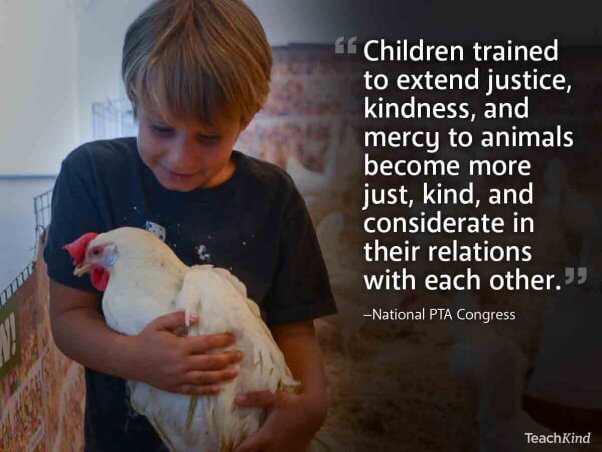
❌ Businesses Selling or Promoting Classroom ‘Pets’ ❌
Many teachers have the best of intentions when considering keeping animals in their classrooms, but even under ideal conditions, a classroom simply isn’t a suitable environment for any animal. We routinely receive reports that animals have been abused in schools—even the most vigilant teachers can’t possibly keep an eye on every child at all times.
And in the case of an emergency evacuation, which students are told to treat as the real thing, classroom “pets” are often left behind, sending the harmful message that the safety of animals isn’t a priority. There are many ways to teach your students about responsibility, proper care of animal companions, animal science, and more without risking a life.
True Humane Education Replacement
Encouraging students to help animals exploited by the pet trade is one form of humane education. Every time an animal is purchased from a pet store or breeder, an animal in a shelter loses a chance at finding a loving home. Familiarize your students with the companion animal overpopulation crisis and the exotic-pet trade, and stress the importance of adopting from shelters—not buying from breeders or pet stores—and of having animal companions sterilized. Not sure how to incorporate these issues into your content area? Check out the way this teacher inspired her students to speak up for betta fish exploited and abused by the pet trade during their unit on citizenship and social justice.
Take these simple yet important lessons in kindness a step further by asking the class to collect gently used sheets, towels, and other supplies to donate to your local open-admission animal shelter. If you can, take a field trip there and arrange for your students to volunteer. When holiday food drives are held for humans in your community, ask students and their families to donate pet food for local animal shelters, too. You could even challenge your class or grade level to collect 100 cans of cat or dog food on the 100th day of school.
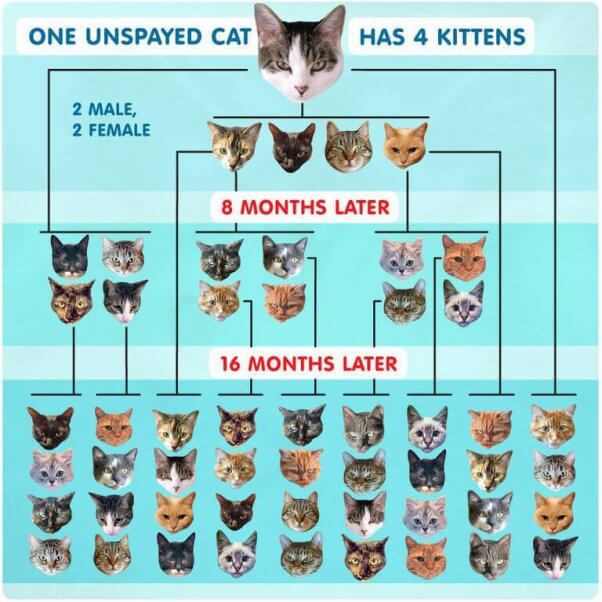
❌ 4-H, the National FFA Organization, and Similar Agriculture Programs ❌
Agriculture programs like 4-H and National FFA Organization (formerly Future Farmers of America) instruct student participants to “identify parts of [their] animal and cuts of meat”—completely desensitizing them to the fact that animals are living beings who have thoughts and feelings and who are worth far more than their parts. Many agriculture programs tout their “nose-to-tail” use of animals as ethical but fail to acknowledge that there is no humane way to kill someone who wants to live—and all animals want to live. Instead of teaching kids that animals are individuals with unique personalities, needs, and emotions, these programs teach them to harden their hearts and view their fellow animals as nothing more than a way to make money. It wouldn’t be unreasonable to be concerned that people who demonstrate such a blatant lack of empathy and disregard for life may be on a dangerous path that could lead to more overt forms of violence. For example, in 2018, an FFA student was accused of dragging a squealing pig by a rope before shooting her in the head with a rifle while on school grounds.
I wish I had spoken up and fought for change when I participated in 4-H.
–Former 4-H participant and 2019 Sexiest Vegan Next Door finalist Daniela Habermehl
True Humane Education Replacement
Exposing the truth about animal agriculture to students is a form of humane education. Show them that every animal is someone—not something—using real-life stories of people helping animals. Each reading comprehension worksheet in TeachKind’s Rescue Stories series tells a different animal’s tale. Featuring key vocabulary words and questions that encourage literal, inferential, and evaluative thinking, these worksheets can be used to address Common Core English language arts standards, and they’re great for English-language learners, too.
There’s an inspiring rescue story for every age group.
- For students in grades K–2: Herman the Duckling’s First Swim, Idabelle’s Great Escape, Pickles the Rabbit, Florence the Cat Survives a Flood
- For students in grades 3–5: Jake’s Recovery, Esther the Wonder Pig, Freddie on the Run, Christmas the Puppy’s First Holiday, Rescued Rats Find New Home
- For students in grades 6–8: Miss Willie’s Bucket List, Waheed and Tracy the Camels Fall in Love, Lucky and the Good Samaritan Who Saved Her, Mayflower the Turkey
- For students in grades 9–12: Hotel Ends Fish-Rental Program, Songwriter and Student Save Lamb From Slaughter, Teens Save a Suffering Squirrel
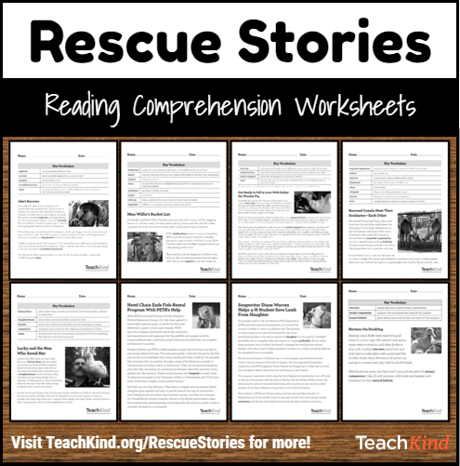
❌ SeaWorld and Other Marine Mammal Parks ❌
While marine mammal parks may claim that they exist for education and conservation, abusement parks such as SeaWorld and the Miami Seaquarium are part of a billion-dollar industry that sends the harmful message that it’s acceptable to imprison animals in small concrete tanks, deprive them of freedom of movement, give them no opportunity to establish natural territory and explore, forcibly breed them, house them in incompatible groups, and watch them suffer from frustration and loneliness. The only valuable lesson to be learned from these parks is that the animals held there are miserable. Children who visit them see mere shadows of the animals’ former selves—defeated, depressed individuals who are deprived of everything that’s meaningful to them.
True Humane Education Replacement
Providing students with accurate information about marine mammal parks and letting them decide for themselves whether animals thrive there is a form of humane education. There’s no denying the facts—marine mammals are highly intelligent, sensitive, social beings who suffer greatly in cramped tanks. Equip students with TeachKind’s Debate Kit: Should Marine Mammals Be Held at Amusement Parks? and let the information speak for itself. Students will learn to speak and write persuasively, practice research skills, consider all aspects of an issue, and come to their own conclusions about the ethics of using marine mammals for entertainment. Check out TeachKind’s other debate kits, all of which include a variety of credible resources that can be shared with students in grades 6–12 to support the argument that animals are not ours to use.
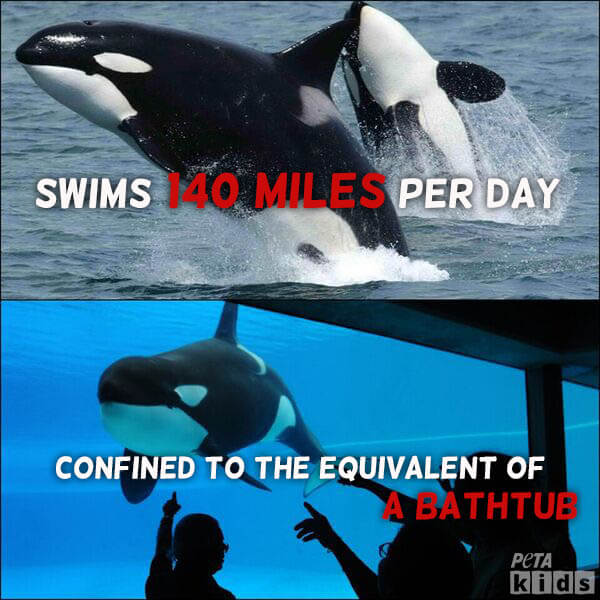
❌ Touch Tanks, Petting Zoos, and Other Businesses Offering Hands-On Experiences ❌
“Keep your hands to yourself” is a good rule that applies to our interactions with animals, too. Although using their hands to manipulate and engage with materials and solve problems helps students learn, they don’t need to put their hands on animals in order to learn about them or appreciate their beauty. Just ask any of your dinosaur-loving students how they learned all about the Tyrannosaurus rex!
Most of us know that if we want to touch someone, we should first ask if it’s OK. Consent is a concept that’s taught—we’re not born understanding it. Touch tank exhibits, petting zoos, and other close encounters with animals teach kids that they don’t have to ask for consent before touching animals or pay attention to the obvious physical signals that others send when they don’t want to be touched.
True Humane Education Replacement
Observing animals in their natural habitats and through exciting animal-friendly field trips is a form of humane education. We can provide our students with authentic, engaging learning opportunities without subjecting any animals to an onslaught of groping hands. Go out into the real world and encourage students to use their eyes and ears—not their hands—to experience life around them. Field trips to your local nature park, forest reserve, or botanical gardens are excellent opportunities to view animals on their own terms. Alternatively, watch a nature documentary or arrange for a virtual field trip. The lessons in self-control and respect for others’ personal space that your students will take away from these experiences far outweigh the fleeting thrill of touching an animal.

❌ Science Curricula That Includes Dissecting Animals ❌
Every animal who ends up on a dissection tray was once alive and didn’t want to die for a science lesson. Cutting into animals—like earthworms, fish, sharks, rats, and cats—promotes speciesism and should never be allowed in a classroom or anywhere else. Companies like Project Lead The Way make false claims that dissecting animals promotes empathy, but smart humane educators can see right through them.
True Humane Education Replacement
You have the autonomy to choose science lessons that encourage students’ curiosity without harming animals. Check out SynFrog, the groundbreaking synthetic dissectible frog that touts wet, lifelike synthetic skin and internal organs positioned to help students learn anatomy. Digital dissection software such as eMind includes modules on species ranging from sea stars to pigs, all with organ identification and built-in quizzes managed in a teacher portal. Encourage young scientists with the many useful and efficacious humane science teaching tools at your fingertips.
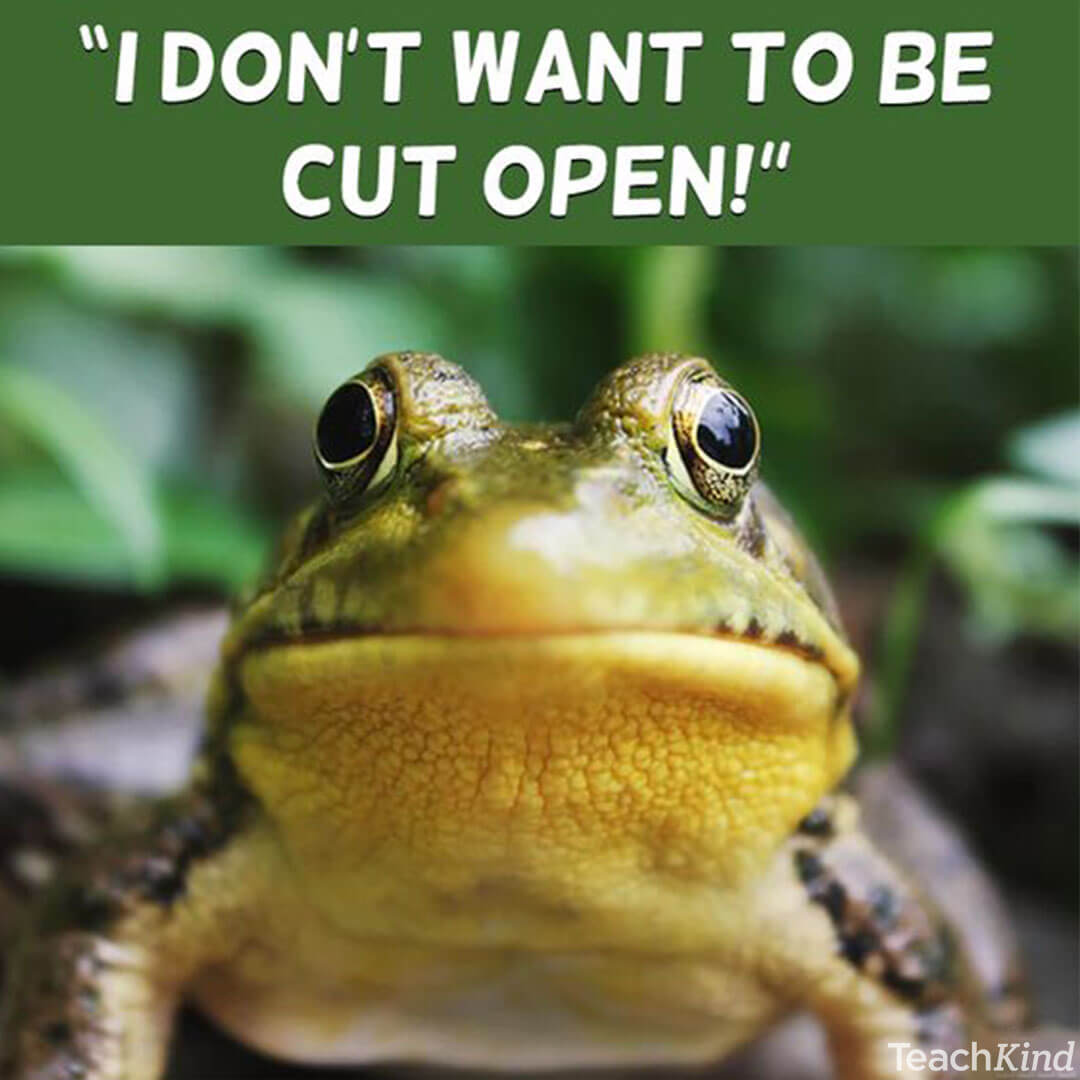
*****
Don’t let these frauds fool you—some businesses use the term “humane education” to deceive well-intentioned teachers and their impressionable students. That’s why it’s up to true humane educators like you to assess available resources carefully. The good news is that TeachKind is a humane education resource that you can trust. The best way to determine whether a resource should have a place in your compassionate curriculum is to ask yourself the following questions:
- Does it promote the use, abuse, or exploitation of an animal (living or preserved)?
- Does it encourage the practice of taking animals out of their natural habitat?
- Who created it, and why?
If the answer to either of the first two questions is “yes” or if the creator of the source will benefit monetarily, choose one of the many humane resources instead. And please don’t hesitate to contact TeachKind for more information.





